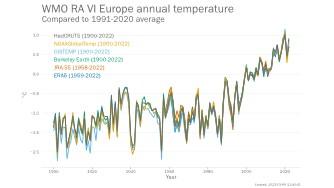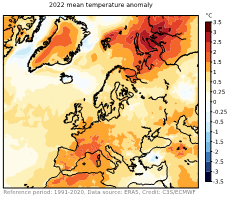Climate change impacts scar Europe, but increase in renewables signals hope for future
Climate change is taking a major human, economic and environmental toll in Europe, the fastest warming continent of the world. The year 2022 was marked by extreme heat, drought and wildfires. Sea surface temperatures around Europe reached new highs, accompanied by marine heatwaves. Glacier melt was unprecedented.

The State of the Climate in Europe 2022 report, the second in an annual series, was produced jointly by the World Meteorological Organization and the European Union’s Copernicus Climate Change Service.
It shows how Europe has been warming twice as much as the global average since the 1980s, with far-reaching impacts on the region’s socio-economic fabric and ecosystems. In 2022, Europe was approximately 2.3 °C above the pre-industrial (1850-1900) average used as a baseline for the Paris Agreement on climate change.
But, in a sign of hope for the future, renewable energy generated more electricity than polluting fossil gas for the first time last year. Wind and solar power generated 22.3% of European Union (EU) electricity in 2022, overtaking fossil gas (20%).
“For the first time, more electricity was generated by wind and solar than by fossil gas in the EU. Increasing use of renewables and low-carbon energy sources is crucial to reduce dependence on fossil fuels,” said WMO Secretary-General Prof. Petteri Taalas. “Climate services play a key role in ensuring the resilience of energy systems to climate-related shocks, in planning operations, and in informing measures to increase energy efficiency,” he said.
The report has a special focus on energy and highlights how more extreme weather, including intense heat, heavy precipitation and droughts have growing implications for the supply, demand and infrastructure of Europe’s energy system.


The report was released to coincide with the 6th European Climate Change Adaptation Conference in Dublin, Ireland, and is accompanied by an interactive Story Map.
“The record-breaking heat stress that Europeans experienced in 2022 was one of the main drivers of weather-related excess deaths in Europe. Unfortunately, this cannot be considered a one-off occurrence or an oddity of the climate. Our current understanding of the climate system and its evolution informs us that these kinds of events are part of a pattern that will make heat stress extremes more frequent and more intense across the region,” said Dr Carlo Buontempo, Director, Copernicus Climate Change Service.
Based on information in the Emergency Events Database (EM-DAT), meteorological, hydrological and climate-related hazards in Europe in 2022 resulted in 16 365 reported fatalities and directly affected 156 000 people.
About 67% of the events were flood- and storm-related, accounting for most of the total economic damages of about US$ 2 billion. Much more severe, in terms of mortality, were the heatwaves, which reportedly led to more than 16000 excess deaths.
“In 2022, many countries in western and south-western Europe had their warmest year on record. Summer was the hottest ever recorded: the high temperatures exacerbated the severe and widespread drought conditions, fuelled violent wildfires that resulted in the second largest burnt area on record, and led to thousands of heat-associated excess deaths,” said Prof. Taalas.

Note: Impact numbers for some disaster occurrences may be lacking due to data unavailability.
Temperatures: Europe saw its warmest summer on record. Several countries, including Belgium, France, Germany, Ireland, Italy, Luxembourg, Portugal, Spain, Switzerland and the United Kingdom had their warmest year on record.
The 2022 annual average temperature for Europe was between the second and fourth highest on record, with an anomaly of about 0.79 °C above the 1991–2020 average. This baseline is used as a standard reference to compare variations in temperature, precipitation etc to the 30-year average and thus provide information to climate sensitive sectors. Precipitation was below average across much of the region in 2022. It was the fourth dry year in a row on the Iberian Peninsula, and the third consecutive dry year in the mountain regions of the Alps and Pyrenees.
France had its driest January to September, and the United Kingdom and Uccle (Belgium) had their driest January to August since 1976, with far-reaching consequences for agriculture and energy production. Spain’s water reserve decreased to 41.9% of its total capacity by 26 July, with even lower capacity in some basins.
Glaciers in Europe lost a volume of about 880 km3 of ice from 1997 to 2022. The Alps were worst affected, with an average reduction in ice thickness of 34 meters. In 2022, glaciers in the European Alps experienced a new record mass loss in one single year, caused by very low winter snow amounts, a very warm summer and Saharan dust deposition.
The Greenland Ice Sheet lost 5 362 ± 527 Gt of ice between 1972 and 2021, contributing about 14.9 mm to global mean sea-level rise. It continued to lose mass during 2022, according to scientific assessments.
Average sea surface temperatures across the North Atlantic area were the warmest on record and large portions of the region’s seas were affected by strong or even severe and extreme marine heatwaves.
The rates of surface ocean warming, particularly in the eastern Mediterranean Sea, the Baltic and Black Seas, and the southern Arctic were more than three times the global average.
Marine heatwaves lead to migration of species and mass extinctions, arrival of invasive species, and disruption of ecosystems and biodiversity.

Energy
Climate variability and long-term climate change impact every aspect of the energy sector: demand, supply and the infrastructure that ensures safe and reliable operations (“the grid”). Climate services and impact data are vital.
The EU is committed to increasing renewable energy production to at least 42.5% of total consumption by 2030 – nearly double 2019 levels.
In 2022, in Europe wind and solar generated 22.3% of EU electricity, for the first time overtaking fossil fuel (20%), and coal power (16%), partly due to a big increase in solar power capacity, according to EMBER’s European Electricity Review.
Additionally, annual surface solar radiation in 2022 was the highest since the start of records in 1983, 4.9% above the 1991-2020 average.
This underlines the importance of meteorological variables: surface solar radiation for photovoltaic, wind speed for wind power, and precipitation and runoff for hydropower.
Generally, more surface solar radiation is available in the south of Europe due to the solar angle and reduced cloud coverage. Wind power potential is higher over the ocean, especially off the coast of Ireland and Portugal and the Aegean Sea. Hydropower is directly linked to the topography of Europe.
The meteorological factors that drive the potential for renewable energy have large seasonal variability. The monthly average of wind speed can vary from –40% to +80% of the average and precipitation ±30%, and surface solar radiation about ±15%.
Solar and wind tend to complement each other throughout the year: solar radiation is higher in the summer half of the year while wind intensity is usually higher in winter.
Over the 30-year period 1991–2020, surface solar radiation has increased, whereas wind speed and precipitation do not show a significant trend.
Nuclear energy
Globally, interruptions to nuclear power operations due to adverse climatic conditions have increased over the past three decades, although they still make up a very small share of total nuclear outages. In 2021, reported weather-related production losses accounted for approximately 0.33% of global nuclear energy generation. Low river flows and increasing temperatures and heat extremes are the major factors.
Under worsening climate scenarios in the long-term, southern Europe could see some of the largest global percentage increases in extreme temperatures above 40 °C and in number of consecutive dry days. This result, particularly for potential nuclear plant sites in southern Europe, underscores the necessity of establishing adaptation provisions associated with strict safety revisions, if the decision is taken that plants should continue to operate.
Climate Services
Climate services – the provision and use of climate information in decision-making, encompassing data collection, monitoring, analysis, predictions and projections of climate variables – play a key role supporting global energy transition to achieve net zero.
Climate services are important for site selection, resource assessment and financing; operations, maintenance, and management of energy systems; electricity integration into the grid; and impact assessment of energy systems.
They are also needed to ensure the resilience of energy systems to climate-related shocks, and to inform measures to increase energy efficiency.
According to a survey of National Meteorological and Hydrological Services (NMHSs) conducted by the WMO, 83% of Members in Europe reported providing climate services for energy. However, less than half provide climate predictions for the energy sector. There is therefore untapped potential of NMHSs to support the energy transition.

Notes to Editors
The WMO State of the Climate in Europe 2022, is the second edition of climate reports to be published annually by the World Meteorological Organization’s Regional Association for Europe (WMO-RA6) and the European Union's Earth observation programme, Copernicus Climate Change Service (C3S). It includes the invaluable contribution of National Meteorological and Hydrological Services (NMHSs), WMO Regional Climate Centre Network for Europe, the Copernicus Climate Change Services (C3S), United Nations (UN) agencies, and numerous experts and scientists from the region and worldwide.
About Copernicus and ECMWF
Copernicus is a component of the European Union’s space programme, with funding by the EU, and is its flagship Earth observation programme, which operates through six thematic services: Atmosphere, Marine, Land, Climate Change, Security and Emergency. It delivers freely accessible operational data and services providing users with reliable and up-to-date information related to our planet and its environment.
The European Centre for Medium-range Weather Forecasts (ECMWF) operates two services from the EU’s Copernicus Earth observation programme: the Copernicus Atmosphere Monitoring Service (CAMS) and the Copernicus Climate Change Service (C3S). They also contribute to the Copernicus Emergency Management Service (CEMS), which is implemented by the EU Joint Research Centre (JRC).
C3S provides authoritative information about the past, present and future climate, as well tools to enable climate change mitigation and adaption strategies by policymakers and businesses. C3S publishes its own European State of the Climate (ESOTC) report and analysis for the preceding year, in April annually.
The World Meteorological Organization (WMO) is a specialized agency of the United Nations responsible for promoting international cooperation in atmospheric science and meteorology.
WMO monitors weather, climate, and water resources and provides support to its Members in forecasting and disaster mitigation. The organization is committed to advancing scientific knowledge and improving public safety and well-being through its work.
For further information, please contact:
- Clare Nullis WMO media officer cnullis@wmo.int +41 79 709 13 97
- Nuria Lopez Press Lead and Communication Account Officer copernicus-press@ecmwf.int Tel: +44 118 949 9778, Mobile: +44 739 227 7523

